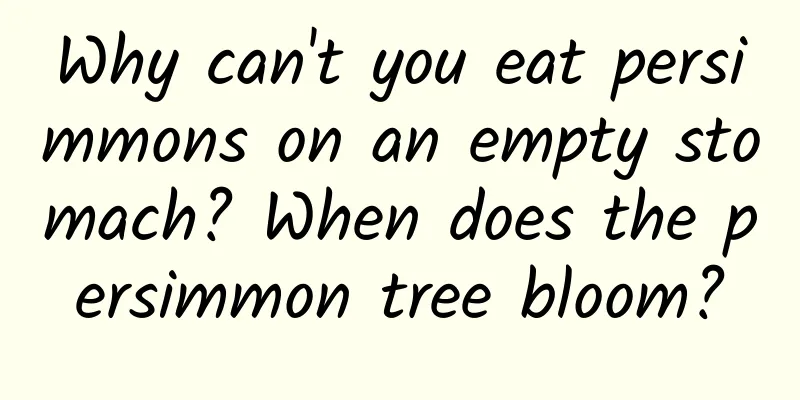Why can't you eat persimmons on an empty stomach? When does the persimmon tree bloom?

|
Persimmon is a short-lived seasonal food. Since it is not available all year round, many people do not know much about it. Today, let's learn some common knowledge about persimmons. First, why can't you eat persimmons on an empty stomach? Second, when does the persimmon tree bloom? Finally, the growth process of persimmons. I hope it will be helpful to you. Contents of this article 1. Why can’t you eat persimmons on an empty stomach? 2. When does the persimmon tree bloom? 3. The growth process of persimmon 1Why can't you eat persimmons on an empty stomach?Because persimmons contain more persimmon gum powder, pectin, tannic acid and tannin, they have a strong astringent effect. When the stomach is empty, the concentration of gastric acid in the stomach is high. After eating persimmons, it is easy to combine with gastric acid to form a hard lump that is difficult to dissolve. After eating more food, the lump gradually grows like a snowball, forming gastric persimmon stones. If gastric persimmon stones cannot be discharged from the body in time, it is easy to cause digestive tract obstruction, or continue to rub the gastric mucosa, leading to severe symptoms such as abdominal pain, vomiting, gastric perforation, gastric bleeding, and gastric erosion. 2When does the persimmon tree bloom?Persimmon trees bloom from May to June. Persimmon is a large deciduous tree of the genus Diospyros in the family Ebisu. It is usually more than 10 to 14 meters tall, with a diameter of 65 cm at breast height; the bark is dark gray to gray-black, or yellow-gray-brown to brown; the crown is spherical or oblong. The branches are spreading, green to brown, glabrous, with scattered longitudinally fissured oblong or narrow oblong lenticels; the young branches are ridged at first, with brown soft hairs or velvet or glabrous. The leaves are papery, ovate-elliptical to obovate or nearly round; the petiole is 8 to 20 mm long. The flowers are dioecious, the inflorescence is axillary, and is a cyme; the pedicel is about 3 mm long. The fruit shape is spherical, oblate, etc.; the seeds are brown, elliptical, and laterally flattened; the fruit stalk is thick and 6 to 12 mm long. The flowering period is from May to June, and the fruiting period is from September to October. 3The growth process of persimmonThe growth process of persimmon is as follows: 1. The growth process of persimmon is different from that of other fruits, and its growth can be divided into two stages. 2. One is the early persimmon, which has a slightly astringent taste. After being artificially de-astringent, it can be eaten, so people call it "filtered juice". 3. The second is a ripe persimmon, with an orange-yellow skin and juicy, sweet flesh. 4. Generally speaking, persimmons will have an astringent taste when eaten right after they are ripe. It is recommended to seal them in a container for a period of time so that the astringency will disappear. |
>>: Can the bladder really explode?
Recommend
What causes blood clots during menstruation?
Women have many common problems during their mens...
Why can't women urinate?
Both men and women may experience the situation o...
Detailed explanation of the symptoms of gastric indigestion, must read
Many people have experienced gastric indigestion ...
Causes of hard lumps in the perineum
Some women will have bumps on their perineum. In ...
How many days after menstruation is the safe period?
Menstruation is a normal physiological phenomenon...
Sudden vulvar itching
Nowadays, most women are busy with their work all...
I have an incompetent cervix. How can I keep my baby?
Author: Zou Liying, Chief Physician, Beijing Obst...
Endometrial biopsy
Endometrial biopsy is a relatively common test cu...
What are the ways for girls to grow taller quickly?
Everyone has a dream of growing taller, wishing t...
Intermittent pain in the left lower abdomen of women
Due to the uniqueness of women's bodies, they...
What happened to my period coming back a week after it was over?
Menstruation can be said to be the symbol of wome...
Small folk remedies for regulating scanty menstruation
In fact, less menstruation is not a good thing, b...
What to do if the incision hurts after cesarean section
It is said that ten months of pregnancy is the ha...
Can low temperatures also cause burns? It can cause necrosis of deep skin tissue
China Science and Technology News, December 1 (Ji...
The incidence of fatty liver disease ranks first among liver diseases, so why do non-fat people also get it?
The incidence of fatty liver disease ranks first ...
![[Technology benefits the people] Our hospital's ophthalmology department independently carried out the first highly difficult level 4 surgery - vitrectomy, and the patient regained clear vision](/upload/images/67f15b4b07889.webp)








